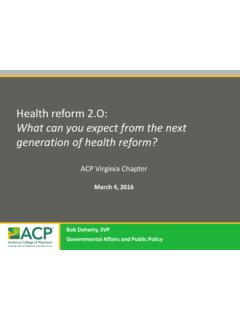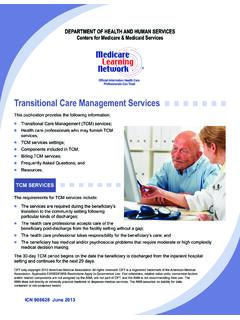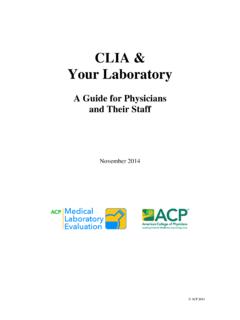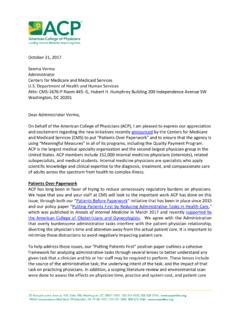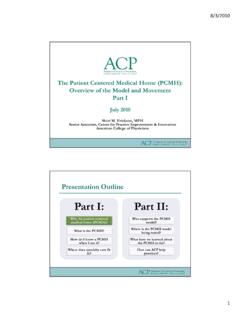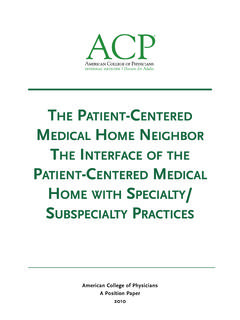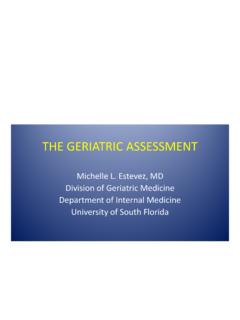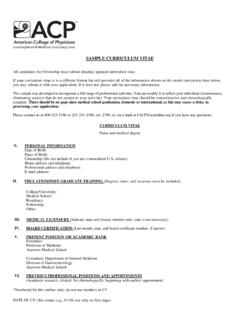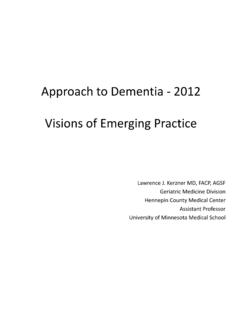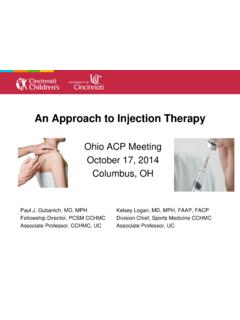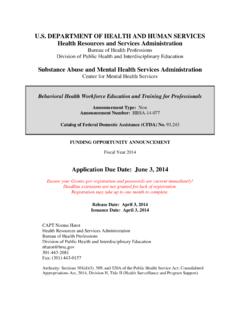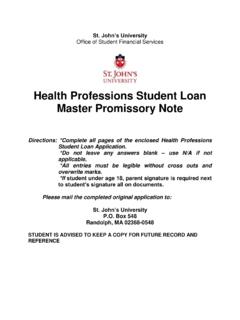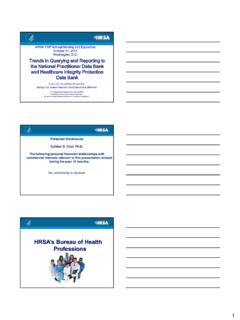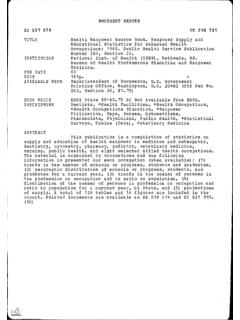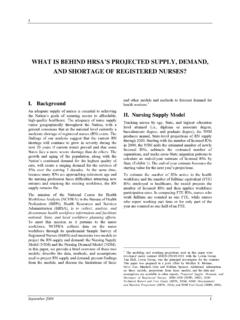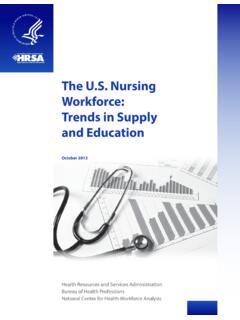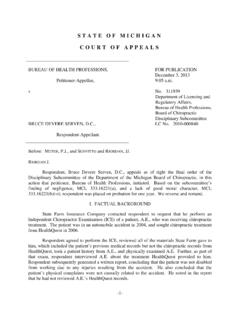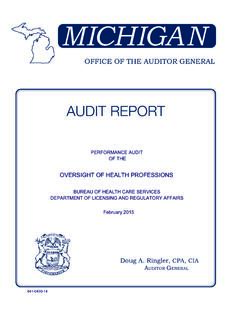Transcription of Title VII health professions education and training programs
1 April 25, 2011 The Honorable Kathleen Sebelius Mary Wakefield, , Secretary Administrator Department of health and Human Services health Resources and Services Administration 200 Independence Avenue, 5600 Fishers Lane Washington, DC 20201 Rockville, MD 20857 Dear Secretary Sebelius and Dr. Wakefield: The 121 undersigned organizations write to thank you for your longstanding commitment to enhance the health care workforce commensurate with the needs of the nation. As you prepare the health Resources and Services Administration (HRSA) s fiscal year (FY) 2011 spending plan for implementing 112-10, we strongly encourage you to continue prioritizing the health care workforce by rejecting proposed cuts to programs within HRSA s bureau of health professions (BHPr). As you know, the bureau of health professions administers critical programs that help shape the workforce to respond to existing and emerging health care challenges.
2 Through support for education and training of health professionals across disciplines, BHPr programs cultivate the next generation of health care providers, including those that care for the most vulnerable, underserved populations. These programs fill the gaps in the private sector and complement efforts across the federal government; indeed, success of all HRSA objectives relies on the availability of well-prepared health professionals like those that graduate from BHPr-supported programs . Many of our organizations support multiple BHPr initiatives, while others participate in specific programs . We all share a common concern, however, that cuts to BHPr will disrupt ongoing efforts to augment the health care workforce and will impede patient access to quality health care. Among such programs : Title VII health professions education and training programs , which enhance the supply, diversity, and distribution of the health care workforce.
3 With their emphasis on primary care and interdisciplinary education , for nearly 50 years the programs have been promoting innovative educational approaches for a range of health professionals, including primary care physicians; physician assistants; dentists; nurses; social workers; allied, public, and mental health providers; and other health professionals. They equip health professionals to adapt to new, improved models of care; facilitate training opportunities in rural and underserved settings and communities; support efforts to recruit and retain a diverse, culturally competent workforce; and strengthen the health professions pipeline, from K-12 to faculty development and across the full range of disciplines. Title VIII nursing workforce development programs , which provide the largest dedicated source of federal funding for nursing education . The high quality care provided by registered nurses and advanced practice registered nurses continues to be in demand, particularly as our health care system focuses on multi-disciplinary approaches to primary care.
4 Moreover, nursing schools continue to face capacity barriers that prevent expanding enrollments needed to build the nursing pipeline. The Title VIII programs help meet these workforce needs by offering support for both education programs and individual students; bolstering nursing education from entry-level through graduate study; and providing financial aid incentives to practice in rural and underserved communities. Children s Hospitals Graduate Medical education (CHGME), which provides critical federal graduate medical education support for freestanding children s hospitals, similar to the support that other teaching hospitals receive through Medicare. The program provides essential support for the future primary care workforce for our nation s children and for pediatric specialty care, the greatest workforce shortage in children s health care. CHGME hospitals train 40 percent of all pediatricians (mostly in general pediatrics), 43 percent of pediatric specialists, and the majority of pediatric researchers.
5 They also provide required pediatric rotations for residents in general internal medicine and family medicine. Workforce Studies under Title VII and the office of Shortage Designation, which serve to compile, synthesize, and report data on the supply and demand of health professionals. From a designation as a local health professions shortage area to studies of regional and national workforce trends, these essential federal functions arm policymakers and the communities they serve with reliable, comprehensive analyses of the health workforce landscape. These initiatives enable better-informed policy decisions for more than 30 programs at HRSA and throughout the federal government. Each of these programs constitutes a relatively small portion of the federal budget, yet their impact is both far-reaching and deeply felt, particularly among the most underserved communities across the country. As a consequence, even seemingly moderate decreases in funding can devastate the ability of the programs to achieve their stated goals.
6 health professionals are the foundation of our nation s health care system. While we recognize the challenging budget environment, we strongly urge you not to jeopardize patients access to care through cuts that will destabilize BHPr s efforts to bolster the health care workforce. Please prioritize funding for the bureau of health professions in HRSA s FY 2011 spending plan. Thank you again for your support, and we look forward to continuing to work with you to advance HRSA s mission and improve the health and well-being of the country. Sincerely, Academic Pediatric Association Alliance for Academic Internal Medicine American Academy of Ambulatory Care Nursing Academy of Medical-Surgical Nurses American Academy of Family Physicians American Academy of Nurse Practitioners American Academy of Pediatrics American Academy of Physician Assistants American Association for Marriage and Family Therapy American Association for Respiratory Care American Association of Colleges of Nursing American Association of Colleges of Osteopathic Medicine American Association of Colleges of Pharmacy American Association of Nurse Assessment Coordination American College of Physicians American College of Preventive Medicine American Dental education Association American Holistic Nurses Association American Medical Student Association American Nurses Association American Pediatric Society American Psychological Association American Society for Clinical Laboratory Science
7 American Society of PeriAnesthesia Nurses Association for Radiologic and Imaging Nursing Association of Academic health Centers Association of American Medical Colleges Association of American Veterinary Medical Colleges Association of Community health Nursing Educators Association of Departments of Family Medicine Association of Family Medicine Residency Directors Association of Medical School Pediatric Department Chairs Association of Nurses in AIDS Care Association of Rehabilitation Nurses Association of State & Territorial Directors of Nursing (ASTDN) Association of Women s health , Obstetric and Neonatal Nurses Beth Israel Deaconess Medical Center BJC HealthCare BLYTHEDALE CHILDREN S HOSPITAL California Association of Alcohol and Drug Abuse Counselors (CAADAC) California Children s Hospital Association California Foundation for Advancement of Addiction Professionals (CFAAP) Cedars-Sinai health System Children s Healthcare of Atlanta Children s Hospital & Medical Center (Omaha, Neb.)
8 Children s Medical Center of Dallas Children s Mercy Hospitals and Clinics (Kansas City, Mo.) Children s National Medical Center Children's Hospital Boston Children's Hospital Central California Children's Hospital of Pittsburgh of UPMC Children's Hospitals and Clinics of Minnesota CHOC Children's Hospital Cincinnati Children's Hospital Medical Center Columbia University Medical Center Connecticut Children's Medical Center Council of Accredited MPH programs (CAMP) Council on Social Work education Creighton University DMC Children's Hospital of Michigan Emergency Nurses Association Florida Association of Children's Hospitals Gerontological Advanced Practice Nurses Association Gillette Children's Specialty Healthcare Hospice and Palliative Nurses Association International Certification and Reciprocity Consortium (IC&RC) Le Bonheur Children's Hospital Long Beach Memorial/Miller Children s Hospital Lucile Packard Children's Hospital at Stanford Michigan State University Mount Sinai School of Medicine National AHEC Organization National Association for Geriatric education National Association of Children s Hospitals National Association of Clinical Nurse Specialists National Association of Geriatric education Centers National Association of Medical Minority Educators, Inc.
9 (NAMME) National Association of Nurse Practitioners in Women's health (NPWH) National Association of Social Workers National Coalition of Ethnic and Minority Nurse Associations National Council for Diversity in the health professions National Hispanic Medical Association National League for Nursing National Nursing Centers Consortium National Student Nurses Association, Inc. Nationwide Children s Hospital New York University North American Primary Care Research Group Northeastern Ohio Universities Colleges of Medicine and Pharmacy Nurses Organization of Veterans Affairs Oncology Nursing Society Penn State College of Medicine Physician Assistant education Association Preventive Cardiovascular Nurses Association Primary Children s Medical Center, of Salt Lake City, Utah Society for Pediatric Research Society for Public health education Society of General Internal Medicine Society of Teachers of Family Medicine St Louis Children's Hospital Stanford University School of Medicine Stony Brook University Medical Center The American College of Nurse Practitioners The Associated Medical Schools of New York (AMSNY)
10 The Children's Hospital of Philadelphia The National Association of Pediatric Nurse Practitioners The National Organization of Nurse Practitioner Faculties Thomas Jefferson University Hospital UC Davis health System University of California, Irvine, School of Medicine University of California, Riverside University of Iowa health Care University of Kansas Medical Center University of Minnesota University of Nebraska Medical Center University of New Mexico health Sciences Center University of Rochester Medical Center University of Utah health Sciences University of Washington School of Medicine University of Wisconsin School of Medicine and Public health University of Wisconsin System
